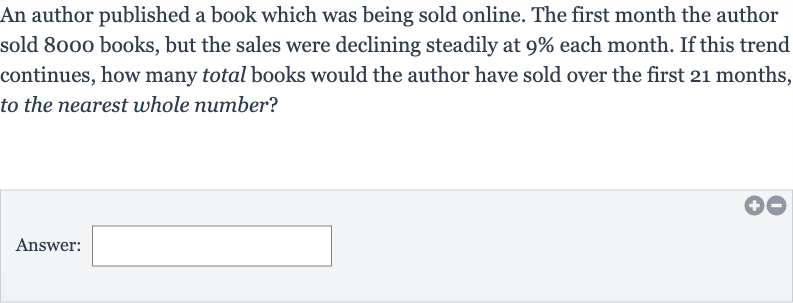AI tutor
Welcome to Bytelearn!
Let’s check out your problem:

An author published a book which was being sold online. The first month the author sold books, but the sales were declining steadily at each month. If this trend continues, how many total books would the author have sold over the first months, to the nearest whole number?Answer:
Full solution
Q. An author published a book which was being sold online. The first month the author sold books, but the sales were declining steadily at each month. If this trend continues, how many total books would the author have sold over the first months, to the nearest whole number?Answer:
- Identify Initial Number: Identify the initial number of books sold and the monthly decline rate.The initial number of books sold is , and the monthly decline rate is .
- Determine Formula: Determine the formula for the total number of books sold over a period of time with a steady decline.The total number of books sold can be calculated using the formula for the sum of a geometric series: , where is the first term, is the common ratio , and is the number of terms.
- Calculate Common Ratio: Calculate the common ratio for the geometric series.The decline rate is , so the common ratio is .
- Apply Geometric Series Formula: Apply the formula for the sum of a geometric series to find the total number of books sold over months.Using the formula , where , , and , we get:.
- Calculate Sum: Calculate the sum . Now, calculate using a calculator. (rounded to four decimal places)Now, substitute this value into the formula.
- Round Total Number: Round the total number of books sold to the nearest whole number.The total number of books sold over months, rounded to the nearest whole number, is approximately .
More problems from Exponential growth and decay: word problems
QuestionGet tutor help
QuestionGet tutor help
QuestionGet tutor help
QuestionGet tutor help
QuestionGet tutor help
QuestionGet tutor help
QuestionGet tutor help
QuestionGet tutor help
QuestionGet tutor help
